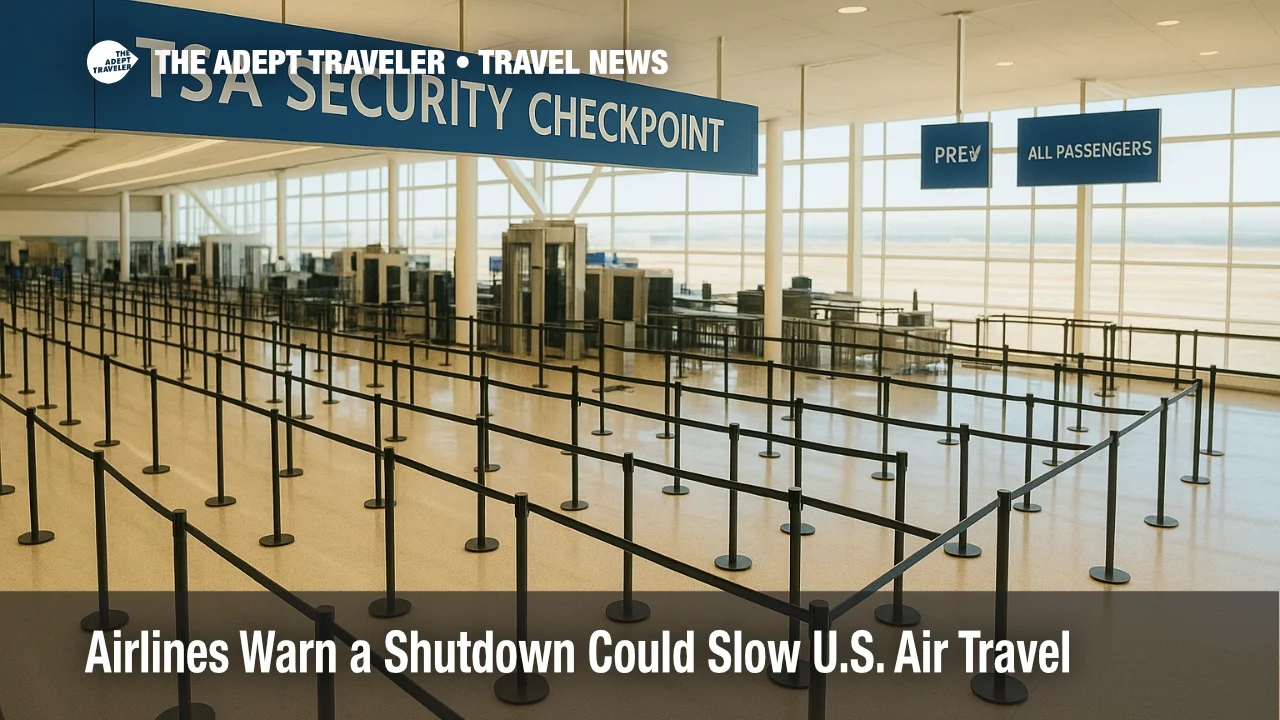Airlines warn a shutdown could slow U.S. air travel

Airlines and aviation groups are sounding alarms that a partial U.S. government shutdown starting October 1 would slow flights, stretch already thin air traffic controller staffing, and ripple across security and safety programs. Trade groups say controllers and most TSA officers would work without pay while key FAA functions pause, creating longer lines, potential delays, and backlogs in hiring and training. Industry advocates also estimate a shutdown would cost the travel economy about $1 billion per week.
Key points
- Why it matters: Fewer on-duty functions and paused FAA programs can slow departures and connections.
- Travel impact: Expect longer TSA lines and potential ATC delays during a shutdown.
- What's next: Congress faces a deadline as airlines flag reduced system efficiency.
- FAA programs: Hiring, training, inspections, and tech upgrades could be deferred.
- Economic hit: Travel groups estimate losses of about $1 billion per week.
Snapshot
Airlines for America warned that to maintain safety during a shutdown "the system may need to slow down," reducing efficiency. A broad aviation coalition added that the FAA would likely suspend hiring and training for controllers and technicians, delay safety initiatives, and postpone maintenance on critical ATC equipment. TSA screening would continue but without pay for most officers retained to work, contributing to morale issues and potential absenteeism. U.S. Travel estimates the travel economy could lose about $1 billion each week due to air and rail disruptions and closures at parks and museums. For practical guidance on what travelers can do if funding lapses, see our earlier explainer, How the potential upcoming government shutdown could affect travel.
Background
The last prolonged shutdown ran 35 days across late 2018 to early 2019, when unpaid controllers and TSA officers contributed to slowdowns, especially in the New York airspace. Today's risk compounds an existing controller shortfall and heavy overtime usage at many facilities. During prior shutdowns, the FAA closed its training academy in Oklahoma City and paused hiring, which takes additional time to restart and deepens staffing gaps. While commercial flights continue to operate during funding lapses, the National Airspace System relies on a balance of staffed positions, ongoing inspections, and modernization work. Pauses to those programs can create downstream delays that persist even after the government reopens.
Latest developments
Airlines and aviation groups outline FAA shutdown impact
A4A, representing United, Delta, American, Southwest, and others, urged leaders to avoid a lapse and cautioned that operations may need to slow to preserve safety margins. A separate coalition of airlines, airports, manufacturers, pilot and controller unions, and business aviation groups detailed expected effects, including furloughs for many FAA employees, suspension of controller and technician hiring and training, delayed safety initiatives, postponed maintenance of critical equipment, and deferred airworthiness inspections. Department of Homeland Security planning documents indicate that TSA would retain most of its workforce on duty without pay, a dynamic that contributed to checkpoint slowdowns in 2019. U.S. Travel reiterated that each week of shutdown could subtract about $1 billion from the travel economy.
Analysis
Safety remains non-negotiable, which is why airlines and the FAA would slow operations rather than stretch resources. The controller pipeline is the choke point; if the FAA suspends hiring and academy classes, today's shortage grows, and overtime fatigue risk rises. That means schedule buffers evaporate quickly when weather or staffing hiccups appear, so minor disruptions become cascading delays. Even if a shutdown is brief, restarting training, inspections, and modernization takes time, creating lingering bottlenecks. TSA's retained workforce plan keeps checkpoints open, but unpaid status historically increases sick-outs and attrition risk, lengthening lines and pushing travelers to arrive earlier. For travelers, the actionable takeaway is to build time into connections, favor morning departures, and monitor airline waivers. For policymakers, preventing a shutdown avoids compounding a known capacity constraint in the National Airspace System at a moment when demand remains strong and on-time performance is closely tied to controller availability.
Final thoughts
If Congress does not fund the government by October 1, travelers should expect slower security and potential ATC-related delays while essential personnel work without pay and FAA programs pause. To minimize headaches, arrive early, carry-on if possible, and leave room in itineraries for irregular operations. For practical tips and airline policy updates, see our earlier guidance piece linked above. Avoiding a lapse is the clearest path to protecting reliability during this period of high demand and limited staffing in U.S. aviation, and to reducing the mounting risks tied to government shutdown travel.
Sources
- A4A statement on potential government shutdown, Airlines for America
- Airlines warn U.S. government shutdown may slow flights, Reuters
- Aviation groups warn of government shutdown impact, Transportation Trades Dept., AFL-CIO
- $1 billion lost every week: Impact of a government shutdown on travel, U.S. Travel Association
- U.S. Travel letter to congressional leadership on shutdown impacts (PDF), U.S. Travel Association
- How the potential government shutdown would impact travel, ABC News (DHS staffing details)
